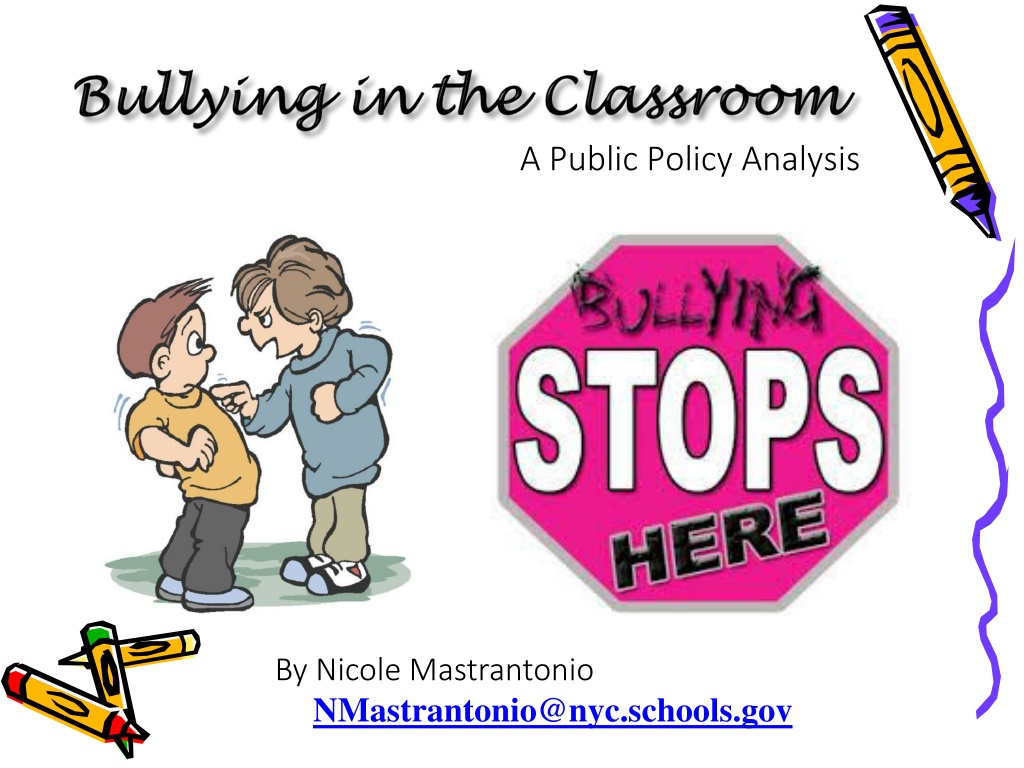
Understanding the Impact of Bullying on Children
Explore the detrimental effects of bullying on children, including loneliness, depression, and engagement in criminal activities. Learn about the causes and prevalence of bullying in various settings such as school, playgrounds, and online platforms.
Download Presentation

Please find below an Image/Link to download the presentation.
The content on the website is provided AS IS for your information and personal use only. It may not be sold, licensed, or shared on other websites without obtaining consent from the author. If you encounter any issues during the download, it is possible that the publisher has removed the file from their server.
You are allowed to download the files provided on this website for personal or commercial use, subject to the condition that they are used lawfully. All files are the property of their respective owners.
The content on the website is provided AS IS for your information and personal use only. It may not be sold, licensed, or shared on other websites without obtaining consent from the author.
E N D
Presentation Transcript
A Public Policy Analysis By Nicole Mastrantonio NMastrantonio@nyc.schools.gov
Define the Problem Gather the Evidence Identify the Causes Evaluate Existing Policy Develop Solutions Select the Best Solution
Bullying involves unwanted and aggressive behavior that may be repeated over time. Such behaviors include hurting one s reputation/relationships spitting pushing teasing name calling saying/writing mean things hitting threatening inappropriate sexual comments taunting leaving someone out tripping kicking embarrassing in public spreading rumors telling someone who to be friends with pinching harassment through texts, social media, the internet, etc.
Children who are bulliedare more likely to experience loneliness experience lose of appetite experience sadness miss/skip/dropout of school be depressed lose sleep have anxiety lose interest in hobbies/activities Children who are bulliesare more likely to engage in criminal activity vandalize property get into fights miss/skip/dropout of school abuse drugs/alcohol get traffic violations engage in sexual activity at an early age abuse their spouse/children as an adult
Surprised?! Bullying can, and does, happen anywhere; in school, on the playground, on the internet, and through texting/social media. The Stats The Stats 1 in 4 children are bullied 1 in 5 children admits to being a bully A child is bullied on the playground every 7 minutes 43% of American students fear being bullied in the bathrooms 100,000 students admit to carrying a gun to school
Have you ever bullied someone? Check Yourself Here! What do you think are some causes of bullying?
Seeking power Bully has been bullied himself and wants to pass it on Seeking attention Causes of Bullying Seeking revenge Mimic behavior seen in movies/TV Bully thinks it s cool or funny
New York State New York State Bullying Policies Bullying Policies Unfortunately, bullying is a serious problem in our schools. The recent rise in number of issues related to bullying leaves both parents and teachers wondering what they can do to stop bullying. The complete policies and guidelines regarding bullying can be found here. Among the current guidelines, New York State law requires: A school environment free of bullying & harassment Teachers, parents, & students to be able to identify the person to whom they should report bullying to Employees/students who witness harassment to report it immediately Serious issues to be reported to the local law enforcement authorities Each school to provide parents, students, & faculty with a copy of such guidelines Use these guidelines during teacher training
What Can We Do?? What Can We Do?? Not in Our School is a campaign that highlights the impact of bullying, and works to put an end to all forms of bullying. Some of their solutions to bullying include: Identifying & monitoring places where bullying is known to frequently occur. Having children role-play to practice what to say to a bully. Having children sign a pledge against bullying. Educating parents & teachers on bullying
The Best Defense The Best Defense I often remind my students that Everyone has been bullied at least once, and everyone has bullied someone else at least once. Unfortunately, bullying is becoming somewhat of a definitive part of childhood. Therefore, I believe that having children prepare themselves for some sort of eventual bullying is important. Children can prepare themselves by role playing, and coming up with a plan. If children are prepared, perhaps when the time comes that they actually are being bullied, it won t be as harmful to them. For example, if the child is has a response already prepared, their confidence is likely to not waver. Additionally, if they are able to stand up for themselves without hesitating, the bully is likely to step down and leave them alone. Is a Good Offense!! Is a Good Offense!!
